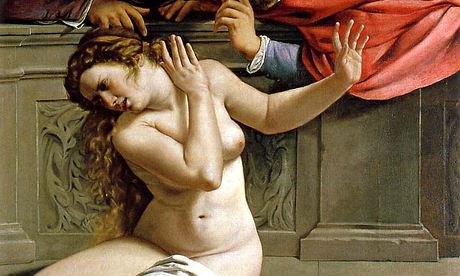
Revealing the history of female artists on television may sound an easy project, a delightful exercise in heritage tourism. Haven't we moved beyond a worthy roundup of forgotten heroines, hidden from history? After all, feminist art history has been investigating the female gaze since Linda Nochlin asked "Why have there been no great women artists?" in 1971. Magisterial surveys and text books have come since, from Germaine Greer's The Obstacle Race (1979) to Griselda Pollock and Rozika Parker's Old Mistresses (1991), enabling art history degrees to offer courses on gender and "ways of seeing" for the last 20 years or so. Engaging TV on the subject of this debate would be easy, I blithely presumed, until I embarked on the simple but fundamental task of seeing female art for myself.
Is art male? Most institutions would have us think so. The disparities are startling. In 1989 the feminist Guerrilla Girls discovered that fewer than 5% of the modern works in the Metropolitan Museum in New York were by women, but 85% of the nudes were female. It is usually possible to see works by one or two women in an entire museum, but you could spend hours looking. I was relieved to find Judith Leyster's tiny but spell-binding Proposition (1631) and Clara Peeters' genre-defining Still Life with Cheeses, Almonds and Pretzels (1621) in the Hague's Gemeentemuseum.
Even Artemisia Gentileschi's masterpiece Judith Beheading Holofernes (1620) has only been exhibited in the Uffizi since 2000. A Medici duchess had banished Gentileschi's assassination scene to a dark corridor, finding her "blood work" too grisly for display.
Weeks of negotiation and an Italian fixer got me into the Vasari corridor to film. This kilometre walkway snakes from the Palazzo Vecchio to the Pitti Palace, crossing the Arno over the Ponte Vecchio. Built in 1564, it allowed the Medici to travel unmolested between their palace and government offices. It is lined with self-portraits by artists, a pantheon of art history from the 16th century onwards. But of the 1,700 self-portraits only 7% are by women.
Did women not paint, sculpt or craft? Or were female efforts so third-rate they did not earn the wall space? The absence of a celebrated female pantheon contrasts starkly with women's success in literature. But the requirements of authorship were far easier to fulfil than the demands of art. Writing required only literacy, access to a library and a desk. Even the risky exposure of publication could be offset by anonymity. By contrast, art demanded complex training, public production and was enmeshed in a well-guarded infrastructure. Unyielding social prejudices, prohibitions on formal training and legal restrictions on female commerce hobbled the woman artist.
I was prepared for a hunt, but nevertheless the near invisibility of women's art was shocking: I was forced into storage facilities and basements. The Advancing Women Artists Foundation estimates that 1,500 works by women are currently stored in Florence's various deposits, most of which have not been on public view for centuries. To the question "Are all of these works of a high artistic standard?" Jane Fortune, head of the foundation, answers: "We'll never know unless they are seen."
Public galleries seem tacitly to endorse the conservative view, exemplified by Brian Sewell's assertion that "only men are capable of aesthetic greatness". But painters and sculptors were artisans working within family-based workshops, just like tailors, locksmiths, goldsmiths and cabinetmakers. Art was a trade. Few paintings were the product of a single hand – only the face and hands might be the work of the "master". The male artist's brand was a fiction. Marietta Tintoretto worked alongside her father in Venice, Barbara Longhi beside her brother in Ravenna, their labour a vital constituent of the family economy, but unrecognised outside the workshop.
A deep belief in the impossibility of female genius is at work. Many of Leyster's sunny canvases celebrating the social life of the Dutch golden age were so skilful they were attributed to Frans Hals, despite her signature.
The Bolognese Elisabetta Sirani produced more than 200 pieces in a 13-year career, garnering international acclaim for her smooth religious art. She ran the family workshop that embraced her sisters, supported her father when he could no longer paint and established an art school for young girls. The very accomplishment, speed and fluency of her art, however, laid her open to the accusation that she could not have created it – a man must have helped her – an accusation she saw off by staging live demonstrations of her painting.
Gentileschi could match the men of counter-reformation art, but chose to dramatise the struggles of women. She depicted the same heroines, even repeating the scenes of her father Orazio, but she charged hers with a pungent critique of male possession of women. The violence of voyeurism is palpable in her Susanna and the Elders (1610), when the cowering woman is victim to the lecherous gaze of two old men. They will accuse her of the capital crime of adultery unless she agrees to sleep with them. Her strong twisting body is displayed, but her horror is uppermost, and her arms are raised in resistance. "What are YOU looking at?" the painting says to us. Compare this with Tintoretto's titillating version in which Susanna seems to know she is being watched and exhibits her white nakedness in an obliging soft performance. The episode becomes a pretext for erotica, and as the woman is complicit in her own subjugation, the dirt of sexual oppression is whitewashed away. Gentileschi will have none of it.
It is not my purpose to suggest that we have yet to discover a female Michelangelo, but it is misleading to look at the past through the eyes of men alone. What women saw was different. Let's remember that.
• The Story of Women and Art continues on BBC2 on 23 and 30 May.

